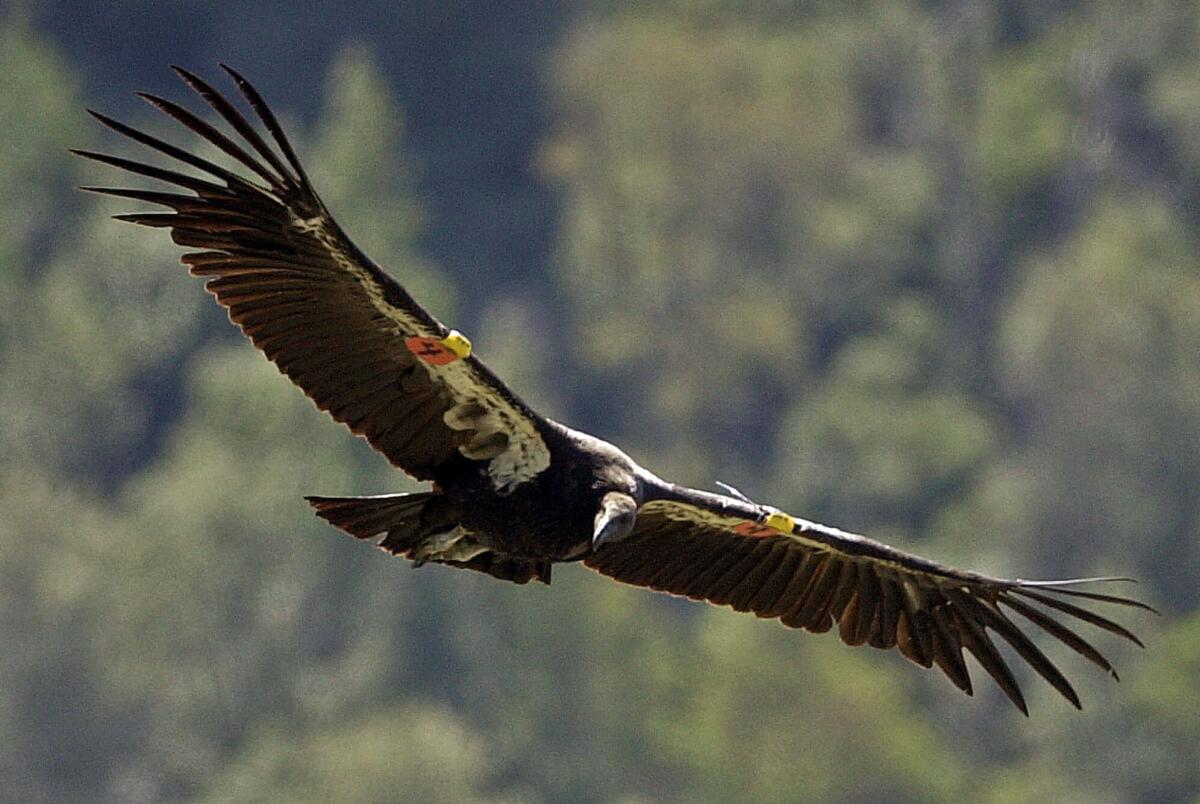Editorial: California condors rise from the brink of extinction

A two–year old male California condor soars in the Ventana Wilderness Sanctuary near Big Sur in 2001.
- Share via
The California condor, North America’s largest bird, once soared through the skies from Washington state to Mexico and into Arizona and Utah. By 1983, however, the loss of habitat and food sources had so crippled the king of the vultures that only 22 were left in the wild.
Over the following four years, the U.S. Fish and Wildlife Service set out to capture all those birds and bring them into captivity for a breeding program to prevent the species from vanishing. One of them, caught near a Kern County ranch in August 1985, was a five year old male that had flown out of a canyon to scavenge for food. Dubbed AC-4 (Adult Condor 4) and possessed of unique DNA, he was put to work spreading his genes across the captive population. He sired 29 chicks, making him the third most productive male in the group.
The preliminary results represent one of the most dramatic turnarounds ever for a critically endangered species.
Gradually, as their numbers rebounded, birds were released back into the wild. Three decades after AC-4’s capture, there are now 235 free-ranging condors — a few dozen more than remain in the captive breeding program. These results, albeit preliminary, represent one of the most dramatic turnarounds ever for a species on the brink of extinction. That’s especially encouraging when officials around the globe are battling to save African elephants, white rhinos and other endangered animals.Tagged and wearing tracking devices, AC-4 was returned last week to the same canyon whence he emerged 30 years ago, in an area that is now the Bitter Creek National Wildlife Refuge. At 35, he is only middle-aged for a condor, and scientists hope he continues to produce offspring.
However, California and the west remain treacherous terrain for these birds. They risk scavenging dead animals whose carcasses have been poisoned by lead bullets or flying into power lines. Governments and scientists have worked to lessen or remove some of these dangers. , California enacted a law in 2013 barring hunters from using lead ammunition anywhere in the state, although the ban won’t be in full effect until July 2019. Meanwhile, power companies and scientists have worked to train captive condors to avoid power lines.
While more than 400 condors may be a promising number, it’s not a sustainable one for a species still on the endangered list. In California, scientists track and recapture them periodically for checkups. But these are animals both grand (nine-foot wing spans) and industrious, scouring carrion from the landscape. Helping them flourish should be seen as part of an ecologically smart effort to keep our environment diverse and healthy for animals and for humans.
Follow the Opinion section on Twitter @latimesopinion and Facebook
More to Read
A cure for the common opinion
Get thought-provoking perspectives with our weekly newsletter.
You may occasionally receive promotional content from the Los Angeles Times.










